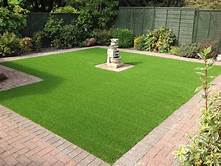Not everyone has the means or wants to use a professional to install their synthetic grass. It is a great feeling when you complete a task on your own, especially a big one in your yard. We get it, the achievement is everything, and we want to help you get there.
Doing it yourself is the cheapest way to install your grass, and it is possible to do without the assistance of an installation company. For a perfect finish without the additional costs, follow along with our guide on installing artificial grass.
Installing Artificial Grass on Dirt Surfaces
Step 1: Pre Installation:
Check for underground hazards
- You need to check for water pipes and electric lines before installing anything. It’s best to cover sprinklers at the pipe level; however, if you no longer require them, get them removed.
- For easy water clear out, add required drainage pipes.
- Move any electric wires from the perimeter by at least six to eight inches to protect them, and so they don’t get damaged when securing the edges of the synthetic grass.
- Lay on top of crushed rock surface.
Step 2: Prepare the Area:
Preparing the base material for your new synthetic lawn is essential for a seamless process.
Rid the weeds
- Kill all grassroots and weeds before installing
- Spray with a non-toxic weed killer with what you are familiar.
- This needs to be undertaken at least two weeks before the installation date.
Remove the top layer of soil
- Removing the top layer of soil makes room for your new base.
- Dig at least three to four inches.
- Apply pressure to the area for any loose soil to harden up.
Drainage plans
- If installing over already well-draining soil, you will have no issues.
- Poorly draining soil will need a drainage system installed.
Installing a blender board
- It would be best if you mapped out the perimeter to have a clean line to separate the other parts of your lawn from the turf area.
- Fencing can act as a guide, so the new synthetic grass doesn’t crawl out of its location.
Optional: Weed barrier installation
- Before laying any base material, layer the bottom of the area with a geotextile layer.
Step 3: Lay the base:
Sub-base material
- Your sub-base material may consist of stone, gravel, crushed rock, decomposed granite, stones or small rocks.
- Scatter 3-4 inches over the base for improved drainage.
- The best sub-base is one that can absorb surface water easily and fast.
Add sharp sand
- Lay 10-155mm of sharp sand on the sub-base to firm it up.
Water the area
- Sprinkle the area with water.
- Only lightly water; otherwise, your sub-base will get washed away.
Compact your stones
- Use a plate compactor or tamper to compact your stones.
- Reduce the base to around 90% of its original depth.
- It should feel like concrete but still have the ability to drain.
- One a budget? Rent or buy a vibratory plate compactor as an efficient, time-saving tool.
Level the entire area
- Check the whole site is even; fill or flatten if it isn’t.
- High areas can be flattened with a rake.
Step 4: Attach your artificial lawn:
Plan the placement
- Note measurements and compare them to your grass size.
- Ensure all the blades are in one direction for a natural look.
- Mark areas with chalk or spray paint for easy reference.
Roll the lawn outside
- Roll the lawn on an even surface (not the one you’re installing on).
- Check your notes.
- Mark the grass by cutting four inches towards the centre from the edge.
Roll the lawn back up
- When rolling the lawn back up, stop when the marked cuts are at the top.
- Cut along the marks for a custom slice.
Roll onto the installation surface
- Roll cut portion over the installation area.
- Hold the edges and shake lightly over the base.
- Don’t drag it over the base, as it’s likely to ruin the smooth surface.
Optional – Use a carpet stretcher
- A carpet stretcher can assist in stretching the grass before fastening them down.
- This method eliminates wrinkles.
- It helps secure the surface tighter to the ground.
Seam the pieces together
- Set each mat as close to each other as you can.
- Butt the sides together like two pieces of material.
- Keep gaps within 1/8 of an inch.
- Cut off excess.
Lay the seam tape out
- Seam tape needs to be cut as long as the edge of the synthetic lawn.
- It then needs to be placed underneath where the sides meet.
- These can be kept in place with 6-inch nails for each corner.
- Grab a helper and ask them to lift the sides of the lawn and hold them.
- Pour in glue and spread evenly over the tape.
Stitch
- Seams need to be butted together a small amount at a time.
- Ensure the grass doesn’t bond together ahead of you laying it down.
Pressure
- Apply pressure to the newly seemed areas to make sure they stick to the tape.
Spike the turf
- For every few inches, hammer nails into the ground.
- Avoid trapping the nail head on the grass fibres.
- Once secured, use anchor pins to fasten grass into place around the perimeter at 6-8inch intervals.
- Secure some along the seam.
- Hammer lightly only because you don’t want to cause dips in the artificial lawn.
Artificial Lawn Post Installation Processes
Trim unwanted grass
- Trim down any artificial turf that is excess by at least 2-3 stitch rows out.
- Avoid grass caving to either side by cutting bits off with a utility knife or grass cutter early.
Optional – For obstructed areas
- If there are any objects in the space, cut the artificial turf around it.
- Cuts should be close enough to let the grass lay flat.
Final Grooming
- Brush the lawn upward to let infill inside.
- Brush grass until the sand sinks below.
- Set infill by watering the synthetic grass.
Additional touches
- Add flowers and herbs in pots to add some colour to your lawn.
- Place outdoor picnic table, play equipment, whatever you can think of to enjoy your space.
Get Scholarships for Online College Degrees










